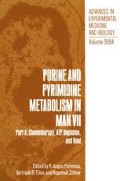Abstract
2-Chloro-2′-deoxyadenosine (CdA) is a congener of deoxyadenosine that is resistant to adenosine deaminase. Rationale for the development of CdA as an immunosuppressive and antineoplastic agent derives from the lymphocytotoxicity of elevated plasma deoxyadenosine in congenital deficiency of adenosine deaminase1. Recent clinical trials have documented promising efficacy of CdA in the treatment of chronic B-cell and T-cell lymphoid malignancies, notably chronic lymphocytic leukemia (CLL) and hairy cell leukemia2,3. Among nucleoside antimetabolites, CdA is uniquely toxic to non-dividing lymphocytes, as well as to most proliferating T-lymphoblasts4. Surprisingly, mature blood monocytes are also lysed by CdA at the nanomolar concentrations readily achieved by continuous infusion in vivo5. In both non-dividing lymphocytes and monocytes, CdA causes the prompt accumulation of DNA strand breaks, with subsequent NAD depletion, inhibition of RNA synthesis, and eventual cell lysis5,6.
Access this chapter
Tax calculation will be finalised at checkout
Purchases are for personal use only
Preview
Unable to display preview. Download preview PDF.
References
D.A. Carson, D.B. Wasson, and E. Beutler, Antileukemic and immunosuppressive activity of 2-chloro-2′-deoxyadenosine, Proc. Natl. Acad. Sci. USA 81:2232 (1984).
L.D. Piro, C.J. Carrera, E. Beutler, and D.A. Carson, 2-Chlorodeoxyadenosine: An effective new agent for the treatment of chronic lymphocytic leukemia, Blood 72:1069 (1988).
L.D. Piro, C.J. Carrera, D.A. Carson, and E. Beutler, Lasting remissions in hairy-cell leukemia induced by a single infusion of 2-chlorodeoxyadenosine, N. Engl.J. Med. 322:1117 (1990).
D.A. Carson, D.B. Wasson, R. Taetle, and A. Yu, Specific toxicity of 2-chlorodeoxyadenosine toward resting and proliferating human lymphocytes, Blood 62:737 (1983).
C.J. Carrera, L.D. Piro, C. Terai, M. Lotz, E. Beutler, and D.A. Carson, Potent toxicity of 2-chlorodeoxyadenosine towards human monocytes in vitro and in vivo: A novel approach to immunosuppressive therapy, J. Clin. Invest. 86:1480 (1990).
S. Seto, C.J. Carrera, M. Kubota, D.B. Wasson, and D.A. Carson, Mechanism of deoxyadenosine and 2-chlorodeoxyadenosine toxicity to non-dividing human lymphocytes, J. Clin. Invest. 75:377 (1985).
A.H. Wyllie, J.F.R. Kerr, and A.R. Currie, Cell death: The significance of apoptosis, Int. Rev. Cytol. 68:251 (1980).
H. Kizaki, H. Shimada, F. Ohsaka, and T. Sakurada, Adenosine, deoxyadenosine, and deoxyguanosine induce DNA cleavage in mouse thymocytes, J. Immunol. 141:1652 (1988).
H.C. Birnboim and J.J. Jevcak, Fluorometric method for rapid detection of DNA strand breaks in human white blood cells produced by low doses of radiation, Cancer Res. 41:1889 (1981).
K.S. Sellins and J.J. Cohen, Gene induction by gamma-irradiation leads to DNA fragmentation in lymphocytes, J. Immunol. 139:3199 (1987).
M. Skalka, J. Matyasova, and M. Cejkova, DNA in chromatin of irradiated lymphoid tissues degrades in vivo into regular fragments, FEBS Lett. 72:271 (1976).
D.J. McConkey, M. Aguilar-Santelises, P. Hartzell, I. Eriksson, H. Mellstedt, S. Orrenius, and M. Jondal, Induction of DNA fragmentation in chronic B-lymphocytic leukemia cells, J. Immunol. 146:1072 (1991).
Author information
Authors and Affiliations
Editor information
Editors and Affiliations
Rights and permissions
Copyright information
© 1991 Springer Science+Business Media New York
About this chapter
Cite this chapter
Carrera, C.J., Piro, L.D., Saven, A., Beutler, E., Terai, C., Carson, D.A. (1991). 2-Chlorodeoxyadenosine Chemotherapy Triggers Programmed Cell Death in Normal and Malignant Lymphocytes. In: Harkness, R.A., Elion, G.B., Zöllner, N. (eds) Purine and Pyrimidine Metabolism in Man VII. Advances in Experimental Medicine and Biology, vol 309A. Springer, Boston, MA. https://doi.org/10.1007/978-1-4899-2638-8_3
Download citation
DOI: https://doi.org/10.1007/978-1-4899-2638-8_3
Publisher Name: Springer, Boston, MA
Print ISBN: 978-1-4899-2640-1
Online ISBN: 978-1-4899-2638-8
eBook Packages: Springer Book Archive

